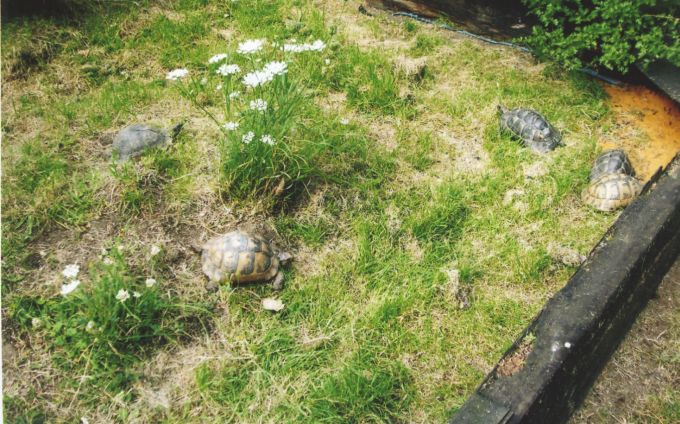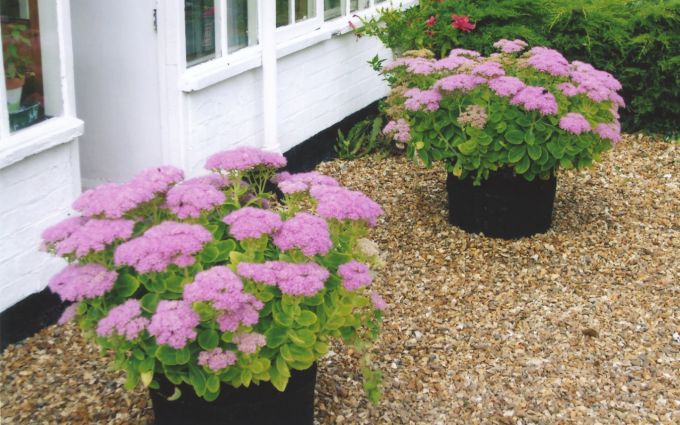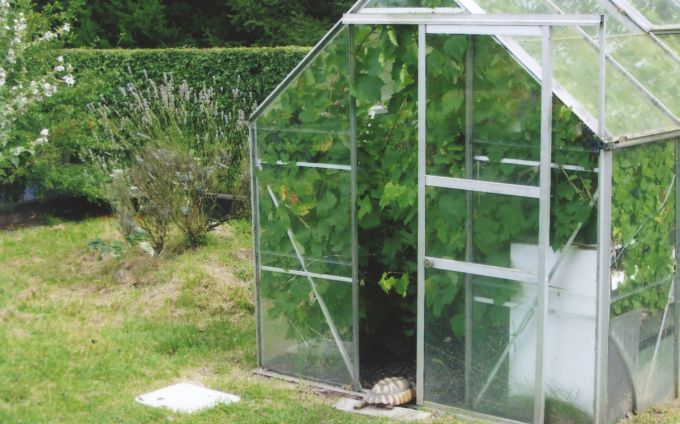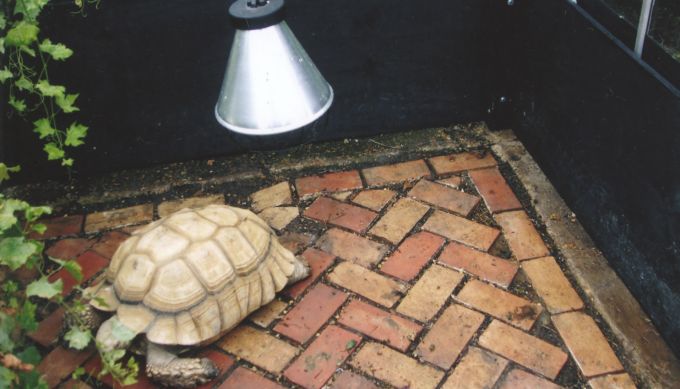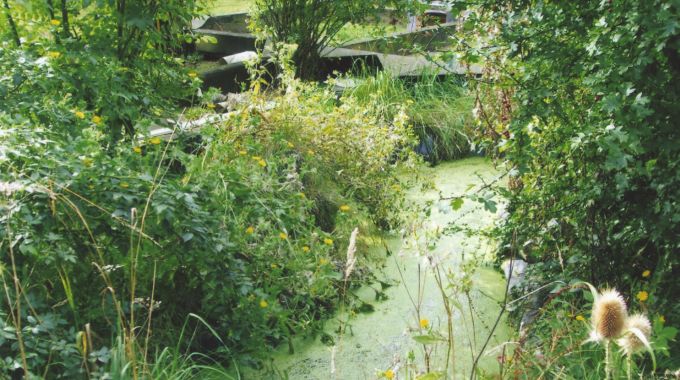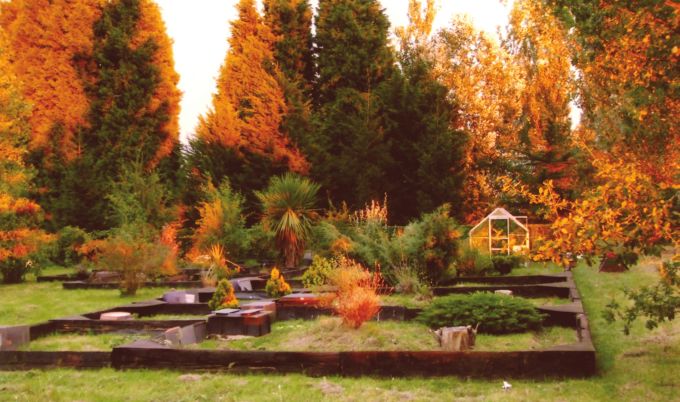Henny Fenwick
Presented to the BCG Symposium at the Open University, Milton Keynes, on 8th March 2008
Introduction
We have to differentiate between keeping chelonia in a home environment in the UK and a home environment in a country where the animals are indigenous. Keeping tortoises in any of the Mediterranean countries is definitely easier! Interestingly, in countries where chelonia are indigenous it very often is an offence to keep them as pets. In France, for instance, you now cannot keep the indigenous Hermann’s tortoise as a pet. The animal may stray into your garden, but you cannot fence it in and claim the animal as yours; it must be allowed to wander out again.
Although within the EU all countries are supposed to submit to CITES regulations, there are a few discrepancies or differences in the implementation of the rules. One of the most interesting aspects is the way that captive breeding is used. If you breed in the UK from CITES 1 species (Hermann’s, spur-thighed, marginated, Kleinmann’s and pancake tortoises) and you want to sell the progeny, you will need to microchip the parents and show proof of parentage. There are also a number of questionnaires to be flled in and applications to be made to a central office (in the UK this is DEFRA in Bristol). Changes are being implemented after every international CITES meeting, often to plug loopholes that have occurred in the legislation imposed previously. Some of the last countries to enter the EU in Eastern Europe actually have indigenous tortoises, including spur- thighed, Hermann’s and marginated tortoises.
As the BCG’s Newsletter Editor I regularly get phone calls from confused members who report Mediterranean tortoise hatchlings for sale in their local garden centres and pet shops. They appear to be legally sold and have licences stating they are captive bred, and one paper appears to cover several hundred animals. The sale is perfectly legal. A Russian dealer explained how he obtained licences for the sale of his Russian ‘captive bred’ tortoises:
“In an area where tortoises are abundant in the wild an enclosure is prepared and sandy areas are provided. A large number of female tortoises are rounded up and put in this enclosure; the sandy heaps are there to encourage them to lay their eggs. They do so, and after the appropriate incubation time the sandy substrate is hosed down. In the wild, hatchlings stay in their nests even after hatching till there is a downpour. There is some logic in this: first of all the earth gets softened by the rain and the animals can then tunnel out, and secondly, after the rain plants are producing nice fresh shoots so food is plentiful, giving them a good start. This is imitated by the water hose. The hatchlings tunnel up and are literally harvested. 10 or 15% are returned to the wild, and for the rest of the animals a licence is obtained so that they can be sold as ‘captive bred’.”
This is perfectly legal, but a nice little loophole that will require plugging eventually. Allegedly, a great number of sulcata giant tortoises have entered the UK in a similar fashion. An Englishman living in the Canary Islands (which are part of Spain) keeps a group of breeding sulcatas and obtains a licence for the progeny because technically the sulcata hatchlings are ‘Captive bred within EU’ and he can then export legally into the UK.
Keeping tortoises in the UK
Keeping our charges in a home environment in the UK requires a little thought. We have to differentiate between hatchlings, juveniles and adults, and also hibernators and non-hibernators (or tortoises of a temperate climate and those from tropical areas). It is also a very good idea to separate males and females or at least have the opportunity to put up a device or a temporary wall to separate amorous males from the females. If you have only a few Mediterranean tortoises, you can give the animals the run of the garden, and as long as there are secure fences, no slug or weed killers in use, a nice secure place to sleep and preferably a greenhouse for more inclement days, your tortoises will thrive.
If your hobby has taken a slightly more passionate turn and you have ended up with rather a lot of tortoises, and of different species, the planning of their habitat requires more than a little thought. First of all, whether from a temperate or tropical climate, outdoor pens are a must – there is nothing like real summer sunshine to keep the animals happy and healthy. Hatchlings and juveniles can be kept in portable pens, giving them every opportunity to feed on clover and edible weeds. Provide shade, and netting to protect from large birds if necessary, and make sure there are no flowers in their enclosures because bee and wasp stings can be fatal to a small creature.
I have lived in my present abode for over thirty years, and knowing my preoccupation with our scaly friends my husband provided me with an acre field adjacent to the house, where over the years I have planned and laid out a tortoise garden with different sections for the various species and subspecies. The garden is constructed by using railway sleepers, resting sideways rather than fat to provide solid walls. A safe wood preservative is used on the sleepers and there is a damp course of plastic strips on the clay soil. You can use bricks or sand as a damp course if preferred. Small wooden triangles are nailed onto the top corners to prevent curious inmates from escaping by using their fellows as a ramp. The garden, with its different sections, takes up about ¼ acre and the rest of the field is mowed once or twice a year on a very high setting.
Both the gardens and the field were laid out to grass (perennial rye grass, a high grade cattle feeder). Having owned this field for over thirty years, it contains edible plants, and I can take my bucket down and pick a variety of edible weeds. Some of these will be mentioned below, as well as some of the plants and herbs that will provide fragrance, encouraging the animals to behave as if they were in their natural habitat. The list of edible wild plants is naturally not complete, but the ones I am mentioning are easily grown from seed. The soil in my part of Cambridgeshire is very heavy clay and that rules out some of the edible plants that flourish on sandy and chalky soil. More complete lists are available in the appendix.
| Edible wild plants for your tortoise garden | Bushes and shrubs | Pots | Herbs |
|---|
| Bindweed | Rose bushes | Cacti (Agave or any of the opuntia) | Basil |
| Black Medick | Brambles | Ice Plant | Fennel |
| Bladder Campion | Brooms | | Lavender |
| Clover varieties - red/yellow/white | Buddleia | | Mint |
| Chickweed | Grapevine * | | Thyme |
| Common Mallow | Hawthorn | | Rosemary |
| Daisy | Lilac * | | Sage (use the edible variety Salvia officinalis) |
| Dandelions | Mallow * | | |
| Forget-me-not | Russian Vine * | | |
| Groundsel | Pines | | |
| Heather | Honeysuckle | | |
| Pansy - Field/Wild | | | |
| Plantain (two varieties) | | | |
| Rosebay Willowherb | | | |
| Sow-thistle | | | |
| Vetches - Yellow/Mauve/White | | | |
| Wild Strawberries | | | |
* Cultivated
Remember, plants in the wild should not be uprooted – collect some seeds or contact a wildflower specialist; there is a wildflower charity which issues a free catalogue¹
The BCG issues packets of Red Clover seed, which are sold via the BCG Newsletter at very little cost. (Thistle, dandelion and common daisy all belong to the daisy family and, surprisingly, so do some cultivated plants such as lettuce and sunflower.)
Not all of the plants growing in my field are available all the year round, certainly not during the winter when my exotics (sulcata, Burmese brown, leopard, pancake and Kleinmann’s tortoises) still need feeding and I do supplement with supermarket greens. An ‘only’ weed diet is not practical during winter. After all, what are supermarket greens? They are merely cultivated weeds, and if you do not have a large, safe field to pick from, supermarket greens are perfectly adequate and valid replacement foods if appropriate vitamin and mineral supplements are used.
As Newsletter Editor I am always amused by the advertisements during the summer months, such as: ‘FOR SALE, hatchling spur-thighed tortoises, fed on a weed diet only and occasional lettuce’. I very often have to phone back to make sure there are licence numbers available (it is illegal for the BCG Newsletter to publish advertisements without a licence being available) and I cannot resist the temptation of asking what weeds are actually being fed. The answer is invariably clover, dandelion leaves and lambs lettuce. It makes me smile: did you know that very mature clover leaves contain cyanide? When slugs stop eating the clover leaves, stop feeding clover to your tortoises; run a lawn mower or strimmer over the clover so that it starts producing fresh new shoots. Dandelion leaves in the summer become rather mouldy, and lettuce contains the hypnotic alkaloid lactucarium, which has the effect of a feeble opium. Your hatchling could be eating a mixture of cyanide, mould and narcotics! This is, if course, highly exaggerated but no more so than insisting on a weed only diet. When you buy your supermarket greens say to yourself these are just cultivated weeds.
Tortoises are fast learners and adapt incredibly easily. Their digestive system is geared to the digestion of cellulose so greens are the obvious food. However, no respectable tortoise living in the wild will ignore a nice bit of protein or fruit when food at the height of the summer is scarce. They do encounter fruits in the wild (prickly pear, wild strawberries/blackberries/rosehips etc.) but these are only available for short periods. It is not normal for a tortoise to eat strawberries all the year round, so use common sense.
Some interesting research has taken place in France and Mallorca with the dietary preference of the Hermann’s tortoise. Both places have a Mediterranean climate, but Mallorca is much drier.
| FRANCE | MALLORCA |
|---|
| Bedstraw family (Rubiaceae) 25% | Bedstraw 10% |
| Pea family (Leguminosae) 20% | Plantain family(Plantaginaceae) 30% |
| Daisy family (Compositae) 10% | Daisy 26% |
Fig. 4. Comparison of the three highest scoring preferred plant varieties in the diet of wild Hermann’s tortoises (after Swingland & Stubbs, 1984).
It proves the versatility of our charges, that they adjust to what is available. Incidentally, SOPTOM (the Tortoise Village at Gonfaron in France) is at present undertaking some new research on the feeding habits of the Hermann’s tortoise. After a local fire, all the dead bodies of the tortoises were collected and put in the freezer. They are using the opportunity of doing post mortem examinations and analysing the stomach contents. It will be interesting to see what emerges from this research.
Indoors
For hatchlings and juveniles vivaria are still the best. Avoid creating an indoor garden, as a vivarium should be easy to wash out. Provide some tissue paper or newspaper on the floor, a cork tile and a piece of slate (both washable) to encourage muscle development, and a simple shelter. Smooth rocks are good, as is a sheet of budgie sandpaper to keep nails in trim.
The American box turtles and hingebacks have to be kept moist and warm, but do not flourish too well in enclosed glass vivaria. They also have a tendency to hide and need a wood bark substrate, caves and gravel as well as bathing facilities. I have special pens laid out indoors (in the conservatory) and outdoors during the summer. The pancake tortoise lives in rocky crevices and the Kleinmann’s tortoise is a sand dune creature, so their vivaria should be arranged accordingly.
In the summer these tortoises flourish on tortoise tables in heated conservatories. You can use old tables or greenhouse shelving, or you can build sturdy ones from chipboard. These tables look attractive and are quite good during the summer months. I once fitted out an entire 10 metre lean-to with such tables using chipboard and was very pleased with the result. They are heavily advocated in the States and I expect in Florida they work very well. However, I have abandoned them except for the juvenile Horsfield’s tortoises: they are definitely too cold in our climate during autumn and spring and unusable in the winter, certainly for very small or tropical animals.
If you have a large herd of tortoises you should have some simple vivaria handy for barrier nursing and isolation, made of a material you can actually wipe down and sterilise. A large glass tank or box made out of laminated wood, a simple top with a light bulb, and a shelter at one end of the vivarium will suffice. For the very large animals, convert a wardrobe. A sheet of clear plastic in the front, a light bulb on one side and a shelter on the other side makes a wonderful vivarium.
Adult Mediterranean and tropical tortoises
Greenhouses to give protection from cold winds and rain are ideal. I try to avoid heat lamps in the greenhouses for the Mediterranean tortoises, except in very early spring.
My tropical tortoises do have outdoor gardens, but a 10 metre long conservatory provides a suitable habitat for most of the year. The tiled floor has a bitumen cover and a thick layer of wood chips. The wood chip layer can be replaced at regular intervals; it soaks up moisture and smells pleasant. Other excreta can easily be picked up from the affected areas and replaced with fresh bark. To avoid food contamination I use cardboard or newspaper for the animals to feed from. After feeding this can be collected and thrown away. The various inmates are separated by dry walls of engineering bricks, supported by some strips of hardboard, and every pen has heat lamps (pig lamps with a 250 Watt bulb per animal). In addition there is a very large central lamp giving out a splendid spray of light, which keeps the animals lively during dull winter days. I will not go into lighting in detail here, but this particular lamp is worth mentioning. It was acquired by courtesy of the Cambridgeshire Police and is in fact the kind of light used by cannabis growers. The lamps have been confiscated by the Police and normally confiscated goods are resold at auction with the proceeds going to charity funds. However, the Police found that the lamps were snapped up at auction by the same people from whom they were confiscated, so they offered some of them to try out on tortoises.
They are extremely heavy to hang and expensive to run. I don't think they do much for ones carbon footprint as my meter consumes electricity rather quickly when the lamp is on; but it is certainly appreciated by the bougainvillea, and I even had two pineapples and a bunch of bananas two years ago – and the tortoise inmates love the light as well.
The sulcata tortoises are of course rather restricted penned in but have their own walled garden with heated greenhouse during the summer months. The substrate in the greenhouse should be sand as these animals like digging, but we had to resort to cementing house bricks onto the floor and had to construct very sturdy wood panels in front of the glass panes all the way along the sides. They were securely bolted to the floor to prevent the two sulcatas from demolishing the glass and entering the garden through the shattered panes. They are mother and daughter, and the younger one remembers how she got out through the door the previous day so tries to ram the wooden panel, and she has been known to emerge in the garden with the greenhouse door strapped around her. We now have a slotted panel on the inside which we slot in place before the door is closed – rather like a rabbit hutch would have, but on a very much larger scale.
In autumn the sulcatas vacate the greenhouse and are put in the conservatory. The greenhouse doubles up in winter as ‘the terrapin house’. The six red-eared terrapins are fished out of the pond in the field using a shrimp net and spend the winter in a heated gosling pond with a heat lamp in the greenhouse. All the outdoor pots and tubs with vulnerable flowers, cacti and herbs are arranged around the pond, adding interest to their environment.
It is now March, and it was a mild winter; not all my charges are out of hibernation yet, but the ones that are will be building up their reserves in the conservatory and greenhouses and making themselves ready for their outdoor summer quarters, where I can enjoy the tortoises and watch the sun going down on their gardens.
EUROPEAN PLANTS OF THE WILD / SAFE TO PLANT OUT
| NAME | DESCRIPTION AND WHERE FOUND |
|---|
BINDWEED
Common Bindweed (Calestegia sepium)
Field Bindweed (Convolvulus arvensis) |
A white flowered climber of hedges, railings.
A pink or white creeper, with trumpet shaped flowers. |
| BLACK MEDICK (Medicago lupulina) | A sprawling, clover-like leaf of open spaces, roadsides, cultivated fields, yellow flowered. |
| BLADDER CAMPION (Silene vulgaris) | White flowered, grey-green branching plant of grassland, arable land and roadsides. |
| CHARLOCK (Sinapis arvensis) | Annual weed of arable land (up to 80cm), yellow flowered. |
CLOVER (RED) (Trifolium pratense)
(T. pratense)
(T. incarnatum) | Meadows.
A clover with deep red flowers.
A long headed hairy seacliff clover with cylindrical flowers. |
| CLOVER (WHITE) (Trifolium repens) | A white flowered clover of grasslands, verges and lawns. |
| COBWEB HOUSELEEK (Sempervivum arachnoideum) | Reddish-pink flower, thrives with little soil on acidic rocks. |
| COLTSFOOT (Tussilago farfara) | On waste and arable land esp. clay soil, yellow flower. |
| COMMON BIRD’S-FOOT TREFOIL (Lotus corniculatus) | Grasslands, yellow peaflowers, clover-like leaves. |
| COMMON CAT’S EAR (Hypochoeris radicata) | Grasslands, yellow dandelion-like flowers. |
| COMMON CHICKWEED (Stellaria media) | Worldwide, annual straggling weed, with tiny white flowers. |
| COMMON DOG-VIOLET (Viola riviniana) | Grasslands, hedge banks, woods; blue-violet flowers. |
| COMMON MALLOW (Malva sylvestris) | A variable, straggling plant of dry open places, waste and cultivated land. Both leaves and mauve flowers are eaten. |
| CRANESBILL (MEADOW) (Geranium pratense) | Meadow plant, bluish-mauve flowers. |
| CREEPING THISTLE (Cirsium arvense) | Fields and roadside, eaten only when young, before mauve flowers appear. |
| DAISY (Bellis perennis) | In short grass of meadow, lawn and verge, white flowered. |
| DANDELION (Taraxacum offcinale) | Grassy and waste places, yellow flowered. |
| FIELD PANSY (Viola arvensis) | On cultivated land, chalky and neutral soils, with variable insignificant flowers. |
| FORGET-ME-NOT (Myosotis scorpioides) | Damp and wet places, leaves and blue flowers are eaten. |
| GROUNDSEL (Senecio vulgaris) | Yellow flowered plant of waste and cultivated ground. |
| HEATHER (Calluna vulgaris) | Wiry scrub of acid soil, young shoots and mauve flowers are eaten. |
| LADY’S BEDSTRAW (Galium verum) | Plant of dry grasslands, golden yellow flowers. |
PLANTAIN
Greater Plantain (Plantago major)
Ribwort Plantain (Plantago lanceolata)
Hoary Plantain (Plantago media) | White flowered.
On pathsides and trodden ground.
In grassy places.
Dry grassy places, chalk and limestone. Only the young leaves are eaten as the plant has furry leaves. |
| REDSHANK (Polygonum persicaria) | Waste and cultivated ground, with spikes of pink flowers. |
| ROSEBAY WILLOWHERB (Epilobium angustifolium) | Tall almost hairless plant of burnt or ploughed ground and hedgerows. Both leaves and rosy purple flowers are eaten. |
SOW-THISTLE
Perennial (Sonchus arvensis)
Smooth (Sonchus oleraceus) |
In waste places, near streams and coast, yellow flowers.
In waste places and as weed of cultivation. |
VETCH
Bush vetch (Vicia sepium)
Common vetch (Vicia sativa)
Horseshoe vetch (Hippocrepis comosa)
Kidney vetch (Anthyllis vulneraria)
Meadow vetchling (Lathyrus pratensis)
Tufted vetch (Vicia cracca) |
Climbing or scrambling in grassy or bushy places. May have short hairy stem, pale purple flower.
Climber of hedges and grassy places, purplish red flower, stem slightly hairy.
On chalk and limestone rocks, yellow flower.
Calcareous grasslands, dunes, cliffs, yellow flower, silky haired stem.
Scrambler over vegetation; grassy or bushy places, yellow flower.
A hairy climber with blue purple flowers, of hedges and bushy places. |
| WATERCRESS (Rorippa nasturtium aquaticum) | A creeper with white flowers in wet places and moving water. |
| WILD PANSY (Viola tricolor) | On cultivated and waste ground, short grassland, blue violet or yellow flowers. |
| WILD STRAWBERRY (Fragaria vesca) | Woods and hedgerows, white flowers followed by sweet red fruits. |
| WOODRUFF (Gallium odoratum) | Clay and calcium rich ground, white flowers. |
SOME SHRUBS AND TREES
For inside, around and near the tortoise gardens as providers of shade, fragrance or food.
| NAME | DESCRIPTION AND WHERE FOUND |
|---|
| BIRCH (Betula pendula) | Peaty sandy soils |
| BLUE HIBISCUS (Alyogyne huegeli) | Evergreen sun loving shrub for poor soil. Lilac flower petals are eaten. |
| BRAMBLE (Rubus fruticosus) | About 2000 micro species are recognised. Both leaves and fruits are eaten. |
| BROOM (Sarothamnus scoparius) | Young shoots have diuretic qualities, pods are poisonous. Shrub of heath, dune or woodland. |
| BUDDLEIA (Buddleia davidii) | Yards, gravel pits, urban areas. White/mauve flowers and leaves are eaten. |
| CHINESE LANTERN (Abutilon hubridum) | An evergreen with white/pink/yellow/red flowers. |
| DOG ROSE (Rosa canina) | Arching scrambler, pink or white flower petals and leaves are eaten, as well as rose hips. |
| GRAPEVINE (Vitis vinifera) | A climbing plant or small bush originating from SE Europe and SW Asia. Fruits are eaten, leaves ignored. Ideal for greenhouses. |
| HAWTHORN (Crataegus monogyna) | Widely distributed in Europe, use as a hedge or a thicket. |
| HONEYSUCKLE (Lonicera periclymenum) | Climbing shrub or scrambler, near hedges and woods. Highly scented flowers. |
| LILAC (Syringa vulgaris) | Deciduous shrub or small tree native of rocky Balkan hillsides, cultivated it grows anywhere. Scented white or mauve flowers and leaves are eaten. |
| MULBERRY TREE (Morus alba) | Leaves are eaten. |
| PINE (Pinaceae) (Pinus sylvestris) | There are 300 species of pine, forming forests in the cooler northern regions and on mountains in the south. Plant Scots Pine near the pen as a provider of shade and scent. |
| RUSSIAN VINE (Polygonum baldschaunicum) | A scrambler or climber with edible leaves. |
| WEEPING WILLOW (Salix vitelli var.pendula) | Parklands, grasslands, near rivers. |
CACTI FOR CONTAINERS OR SANDY HABITATS
AGAVE cacti (Agave americana americana, Agave sisalana) or any of the Opuntia spp are the best for planting out in containers.
HERBS FOR FRAGRANCE
Culinary herbs can be planted out in the enclosures, on the mounds or in the containers. Balm, basil, bay, chervil, fennel, marjoram, mint, parsley, rosemary, sage, sorrel, tarragon and thyme are all easily grown from seed. Tarragon and fennel will come up year after year and apart from smelling attractive, look attractive as well.
| BASIL | (Ocimum basilicum) |
| FENNEL | (Foeniculum vulgare) |
| LAVENDER | (Lavandula angustifolia) (The French variety is highly scented) |
| MINT | (Mentha spicata) |
| THYME | (Thymus drucei) Use the cooking variety (T. vulgaris) |
| ROSEMARY | (Rosmarinus) Use the edible variety, R. offcinalis (see poison list) |
| SAGE | (Salvia) Use the edible variety, S. offcinalis (see poison list) |
FRAGRANT AND TRAILING PLANTS FOR CONTAINERS AND ROCK GARDENS
| NAME | DESCRIPTION |
|---|
| ALYSSUM (Lobularia maritima) | Annuals and perennials, sun-loving, white or yellow flowered and honey scented. For container use. |
| AJUGA (Ajuga reptans) | A ground cover with spikes of blue flowers and green or bronze leaves. |
| BELL FLOWERS (Campanula spp.) | Spring rock plants, blue or white flowered for container use or the rockery. |
| GERANIUMS (Geraniaceae) | There are many species, some scented. For container use. The brightly coloured flower petals are eaten. |
| ICE PLANT (Sedum spectabile) | Both fleshy leaves and flowers are eaten. |
| MUSK (Mimulus moschatos) | A creeper for containers. |
| NASTURTIUM (Tropaeolum majus) | For container use. Both leaves and flower petals are eaten. |
| POACHED EGG or MEADOW FOAM (Limnanthes douglasii) | A hardy annual ideal for edging or containers with sweetly scented yellow flowers. |
| PURPLE ROCK CRESS (Aubretia deltoidea) | For the rock garden, with mauve / purple flowers. |
| SWAN RIVER DAISY SUMMER SKIES (Brachycome iberidifolia) | Half hardy annual, loving sun and producing a mass of white and pink flowers. For container use. |
| WALLFLOWER (Cheiranthus spp.) | Colourful, fragrant and edible |
PLANTS TO AVOID
Before planting up your tortoise garden it is useful to remember that there are a number of ‘plant families’ containing some very poisonous plants.
Most members of the Arum family (Araceae) are poisonous; these include mostly tropical Arum lilies from florists shops which in reality are not lilies at all. Also poisonous are some members of the Buttercup family (Ranunculaceae); the Lily family (Liliaceae) of which the Lily-of-the-valley is perhaps the best known; the Nightshade family (Solanaceae), the Periwinkle family (Apocynaceae) and the Spurge family (Euphorbiaceae); Dogs Mercury is an example of the last one.
Poisonous plants usually produce unpleasant smells or are bitter to the taste and most tortoises are experts in avoiding them, but as the aim is to produce a tortoise friendly garden it is better to eliminate these poisonous plants from the enclosures. The list of poisonous plants growing freely in the wild is obviously not conclusive but exclusion or removal of the plants mentioned below will make your enclosures a great deal safer, especially for juveniles.
POISONOUS WILD PLANTS
| ANEMONE (Anemone nemorosa) | All parts |
| BITTERSWEET (Solanum dulcamara) | Berries |
| BLACK BRYONY (Tamus communis) | Berries and leaves |
| BROOM (Sarothamnus scoparius) | Seeds (young shoots are safe) |
| BUTTERCUP (Ranunculus acris) | All parts |
| COMMON PRIVET (Ligustrum vulgare) | Berries and leaves |
| COWBANE (Cicuta virosa) | Whole plant |
| CROCUS (Crocus vernus) | Bulbs |
| DAFFODIL(wild) (Narcissus pseudonarcissus) | Bulbs |
| DEADLY NIGHTSHADE (Atropa belladonna) | All parts esp. the root |
| DOGS MERCURY (Mercurialis perennis) | All parts |
| DOGWOOD (Cornus sanguinea) | Fruits slightly poisonous |
| ELDERBERRY (Sambucus nigra) | Leaves, shoots + bark |
| ENGLISH IVY (Hedera helix) | Berries |
| FOXGLOVE (Digitalis purpurea) | Whole plant |
| HELLEBORE (Helleborus foetidus) | All parts |
| HEMLOCK(Poison) (Carnium maculatum) | All parts fatal |
| HOLLY (Ilex aquifolium) | Leaves and berries |
| HORSE CHESTNUT (Aesculus hippocastanum) | All parts |
| HORSETAIL REED (Equisetum telmateia) | All parts |
| IRIS (Iris pseudacorus) | Underground stems |
| LILY-OF-THE-VALLEY (Convallaria majalis) | All parts |
| LABURNUM (Laburnum anagyroides) | Pods |
| LAUREL (Cherry) (Prunus laurocerasus) | All parts |
| MISTLETOE (Viscum album) | Berries are fatal |
| MONKSHOOD (Aconitum ranunculacea) | Foliage + fleshy roots |
| NATAL CHERRY or Black Nightshade (Solanum nigrum) | Berries |
| NIGHTSHADE see Deadly and Bittersweet | All parts, esp. unripe berries |
OAKS Common Oak (Quercus robur)
Red Oak (Quercus borealis)
Durmast Oak (Quercus petraea) | Foliage + leaves
|
| PERIWINKLE (Vinca minor) | Whole plant |
| POPPY (Papaver rhoeas) | All except California poppies are dangerous |
| RAGWORT (Senecia jacobaea) | All parts |
| REDWOOD (Taxodiaceae) | Woodchips of these trees are poisonous to chelonia |
| RHODODENDRON (Rhododendron ponticum) | All parts are fatal |
| TANSY (Tanacetum vulgare) | All parts |
| YEW (Taxus baccata) | Foliage + berries |
POISONOUS PLANTS, CULTIVATED OR INTRODUCED AND FOUND IN HERBACEOUS BORDERS OF GARDENS OR IN THE HOME.
| ANGEL TRUMPET (Datura arborea) | Flowers and leaves |
| TREE APPLE (Malus spp.) | Seeds when crushed |
| APRICOT (Prunus armeniaca) | Seeds |
| BELLADONNA LILY (Amaryllis belladonna) | Bulb contains alkaloids |
| CHERRY (Prunus spp.) | Twigs and foliage |
| CHRISTMAS ROSE (Helleborus ruger) | All parts esp. leaves |
| DELPHINIUM (Delphinium consolida) | All parts |
| ELEPHANT EARS (Philodendron hastatum) | Plants and fruit |
| EUCALYPTUS (Eucalyptus maculata) | Leaves |
| HYACINTH (Hyacinthus orientalis) | Bulbs can be fatal |
| IMPATIENS (Impatiens glandulifera) | Whole plant (including Balsam, Touch-me-Not, Snapweed) |
| LOBELIA (Lobelia infata) | All parts |
| LUPIN (Lupinus polyphyllus) | Seeds |
| PEONY (Paeonia spp.) | All parts |
| PINKS (Dianthus spp.) | All parts (including Sweet William, Carnation) |
| PLUM (Prunus spp.) | Seeds |
| POINSETTIA (Euphorbia pulcherrima) | Leaves, fowers and sap are fatal |
| POTATO (Solanum spp.) | Sprouts and foliage are fatal |
| RHUBARB (Rheum rhaponticum) | Leaves are fatal (stems cooked for human consumption) |
| ROSEMARY (Rosemarinus spp.) | Leaves of certain varieties are harmless, others are poisonous |
| SAGE (Salvia spp.) | See Rosemary above |
| STAR-OF-BETHLEHEM (Ornithogalum spp.) | All parts |
| TIGER LILY (Lilium tigrinum) | All parts |
| TOBACCO PLANT (Nicotiana tabacum) | All parts |
| TOMATO PLANT (Solanum spp.) | All parts, except fruits |
| TULIP (Tulipa sylvestris) | All tulip bulbs |
| WISTERIA (Wisteria, Wistaria spp.) | Seeds and pods |
| YELLOW JASMINE (Gelsemium sempervirens) | All parts (Jasmine from Virginia) |
| WHITE BRYONY (Bryonia dioica) | Berries |
Reproduced from Taking care of tortoises, their eggs and hatchlings by H. Fenwick.
¹Landlife Wildfowers Ltd, The Old Police Station, Lark Lane, Liverpool L17 8UU
Testudo Volume Six Number Five 2008
Top


